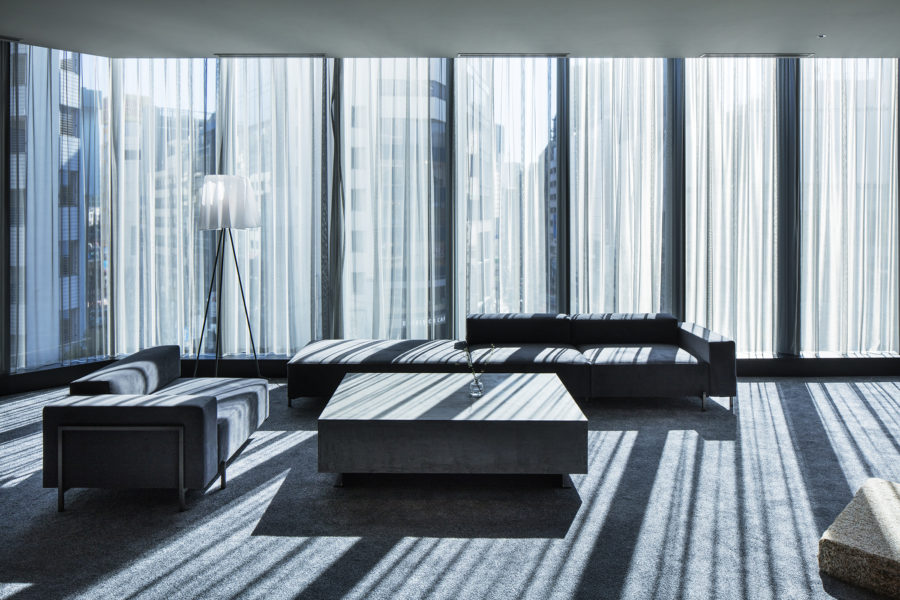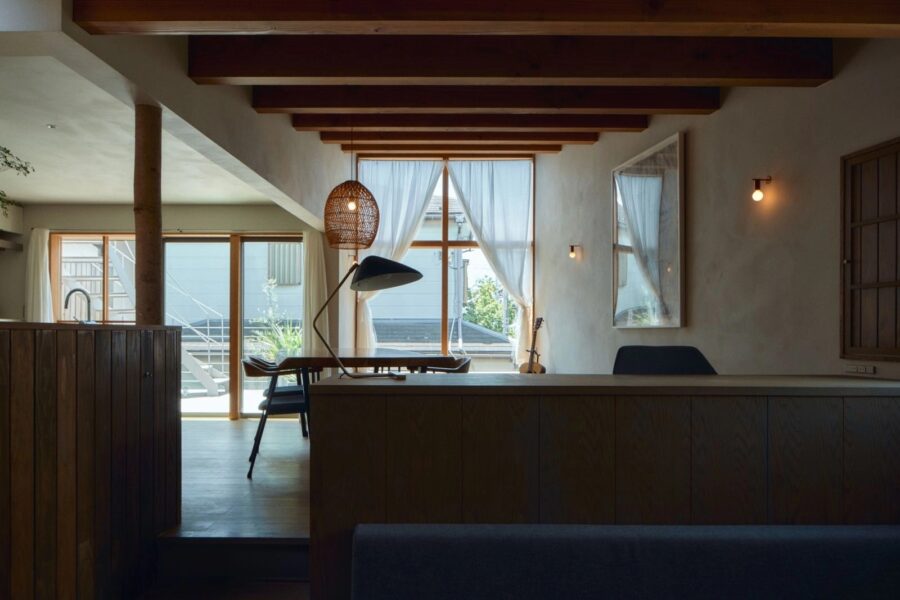〈House of Many Arches アーチだらけの家〉は神戸市にある築35年の木造住居兼事務所の改修計画。もともと賃貸アパートを含む事務所兼住居として建てられたこの建物は、阪神・淡路大震災後に住居と事務所だけの職住融合住宅に改築された。
その後、建主の事情により業務を解散する運びとなり空き家となってしまい、24d-studioは今後の職住融合住宅の在り方を再定義する方向性をとり、更新することを図った。
調査の結果で耐震補強はもちろんのこと、断熱、採光、通風などの環境設備面で不備があり、部屋の区分化が息苦しい雰囲気を与えた。開放的で快適な職住融合の生活スタイルに合わせるため、プロジェクトの課題はレイアウト全体を再構成して広々としたワークスペース、最大限の採光と通風を与え、耐震補強と断熱性能をアップグレードすることであった。
プロジェクトの重要なエレメントはアーチ開口耐力壁の導入となった。各アーチ開口部は計画的に配分されており、構造的な補強を可能にしつつ各部屋に空間的流動性を提供した。壁は一般的に各部屋の分割するものとして認識されているが、アーチ開口壁ではスペースが互いに溢れあうように仕組んだ。日常タスクの機能に応じて各部屋の収縮と拡張、スペース同士の折衝が発生する。
耐震補強の一環として柱と梁の補強に加え、束石を排除し、既存の布基礎をベタ基礎へ変更することで1階の天井高を増し、スタジオのワークスペースを開放的にした。事務スペースとワークショップスペースもシームレスにつなげることもできた。
スタジオの玄関口はミーティングスペースだが、照明デザインを展示するギャラリースペースにも変換できる。
アーチ開口部は全体的な白塗装と対象に、淡色塗装とし空間の特徴を強調しつつ、隣接する部屋とのユニークな関係を築いた。ミーティングスペースとワークスペースを区分化したアーチ開口壁は、ビルトイン収納と展示台としての機能をもつものもある。ワークショップ手前のアーチ開口壁はプライベートなワークスペースとなる。
住居空間へのホワイエはスタジオと北側の外部廊下よりアクセスが可能になっており、吹き抜け階段の手摺り面は2階アーチ開口部とリンクさせ、各階との関係性を示唆している。アーチ開口壁は、既存丸太梁までの高さに設定することで新と旧のエレメントの融合を図り、天井高をより拡張した。2階住居空間は全体的に自然光で溢れ、見渡しのよい日常風景を生む。異様ながらも調和された空間関係が表現されるようになった。
2つのバルコニーはイエローとマゼンタの鮮やかな色彩を取り入れた。これらの独特の視覚効果とその輝度により、室内への明るい雰囲気を与えることができた。日常の中の非日常、それがいつしか暮らしのニューノーマルへと変貌する。(平川フミオ+トプノバ・マリナ)
A house that combines work and housing that uniquely connects rooms by making heavy use of functional arch openings
“House of Many Arches” is a gut renovation of a 35-year-old house in Kobe, Japan. The goal was to transform into a design studio with workshop space on the first floor and a residential section on the second floor.
Originally built with a function of four rentable apartment units and a small office, the house went through a series of renovations after the Great Hanshin-Awaji Earthquake in 1995, transforming into a work-live space. While the spatial configuration worked for the programmatic goals, the survey revealed misalignment and weakening of structural systems due to past renovations. The residential quarter also was heavily compartmentalized, resulting in an overall lack of natural lighting and ventilation.
With the desire for more openness and comfort, the challenge of the project was to reconfigure the overall layout to provide a spacious work-live space with minimal compartmentalization to allow plenty of light and air throughout each space. Renovation efforts mainly focused on interior space with a focus on structural and seismic reinforcement and improvement of climate control performance with the upgrading of windows, doors, and insulation systems.
The key element of the project was the contemporary addition of structural arch walls. Each arch opening was strategically allocated throughout the spaces while providing an overall spatial fluidity across different rooms. The wall is traditionally seen as a dividing element of the space, but with the arch walls, spaces flow onto each other, allowing the rooms to contract and expand without full separation. The spaces are easily adaptable to different daily tasks and functions.
The previous first floor of the house had raised floor levels with the residential sector elevated on wood posts supported on its footings. To create connected studio and workshop areas and improve overall structural performance, the stem wall foundation was converted to the mat foundation.
The entry to the studio begins with a meeting space that is occasionally converted into a gallery showcasing the studio’s lighting design products. Playful hexagonal windows separate the meeting area from the studio’s main workspace on one side and a fat pink structural arch serving as a display and storage niche on the other. Another pink arch with a built-in desk operates as more private work and reading area. Throughout the first floor, arch openings with painted intrados highlight different characters of the space revealing unique relationships with adjacent spaces without breaking the overall continuity of space.
The residential foyer is accessible from the back end of the studio through the yellow sliding door as well as from a separate entryway at the northern corridor outside. The stairwell acts as a connection between two floors, with its rail surfaces merging to the intrados of the second-floor arches. The much-needed natural light freely spills throughout second-floor space due to the insertion of structural arch walls, which subdivide residential programs without obscuring light and views. Previously hidden within dark attic space, but now revealed old architectural log beams add unique historic character with its outlandish presence.
Vivid colors of yellow and magenta were incorporated at two exterior balconies. These peculiar visual effects and their color luminance affect the exterior atmosphere and indirectly enhance the brightness of the interior space. While the exterior façade is simply finished with white paint, yellow railings around the balcony and their supporting structure add a touch of pop to the surrounding housescapes. An extraordinary moment in our everyday life, eventually turning into a new normal. (Fumio Hirakawa + Marina Topunova)
【House of Many Arches アーチだらけの家】
所在地:兵庫県神戸市
用途:戸建住宅・事務所
クライアント:個人
竣工:2020年
設計:24d-studio
担当:平川フミオ+トプノバ・マリナ
構造設計:萬田隆、童双(tmsd萬田隆構造設計事務所)
施工:山本工務店
撮影:杉野 圭
工事種別:リノベーション
構造:木造
規模:地上2階
敷地面積:199.31m²
建築面積:156.65m²
延べ床面積:210.37m²
設計期間:2018.05-2019.08
施工期間:2019.09-2020.03
【House of Many Arches】
Location: Kobe-shi, Hyogo, Japan
Principal use: Residential / Office
Client: Individual
Completion: 2020
Architects: 24d-studio
Design team: Fumio Hirakawa + Marina Topunova
Structure engineer: Takashi Manda, Sou Dou / tmsd Takashi Manda Structural Engineer
Contractor: Yamamoto Koumuten
Photographs: Kei Sugino
Construction type: Renovation
Main structure: Wood
Building scale: 2 stories
Site area: 199.31m²
Building area: 156.65m²
Total floor area: 210.37m²
Design term: 2018.05-2019.08
Construction term: 2019.09-2020.03








